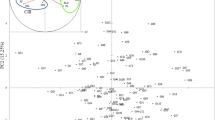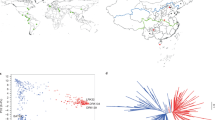Abstract
We used a Diversity Fixed Foundation Set comprising 48 inbred lines of Brassica juncea and representing all the adaption zones of the crop for association mapping. Extensive phenotypic variations were observed for all the grain yield components and root traits under both irrigated and restricted moisture conditions. The genotypes differed in their responses to moisture stress. Trait averages declined numerically under restricted moisture conditions when compared to a standard irrigation schedule. Canonical analysis demonstrated the importance of primary branches and seed size as the traits of significance for drought susceptibility index. Microsatellite markers (158), representing all the 18 chromosomes, were used to assess the population structure, linkage disequilibrium (LD) in the association panel and marker–trait associations (MTA's). A comparison of four association models [general linear model/GLM(Q-matrix/Q), mixed linear model: MLM(Q+kinship matrix/K), GLM (principal components/PC) and MLM(PC + K)] showed that GLM(PC) and MLM(PC + K), incorporating principal components and kinship matrix, were the best models. Maximum proportions of significant results were observed in the models GLM(PC) and MLM(PC + K). MLM was preferred as there were fewer false positives than GLM. Thirteen significant associations were detected between the molecular markers and agronomic traits. Of these, seven were identified under normal moisture conditions, and six under restricted moisture conditions. Marker–trait associations included four markers associated with grain yield, three with seed size, two with secondary branches and one marker each with plant height, root diameter and root length. A single marker SB1822-1, was repeatedly detected for seed size and grain yield, and was localized at 17.5 cM (centiMorgans) on chromosome B3. Marker SB3872-3 revealed a significant effect under normal moisture conditions on seed size (R 2% = 15.16) at 60.9 cM on chromosome B5 during the first year. Among the favorable alleles, SB1822-1 had the average positive phenotypic effect for seed size and grain yield. Marker cnu316-3 had maximum positive phenotypic effects on grain yield.




Similar content being viewed by others
References
Afifi A, Clark V, May S (2004) Computer-aided multivariate analysis, 4th edn. Chapman & Hall/CRC, Boca Raton
Banga SS, Banga SK (2009) Crop improvement strategies in rapeseed-mustard. In: Hegde DM (ed) vegetable oil scenario: approaches to meet the growing demands. ISOR, Hyderabad, pp 13–35
Bañuelos GS, Dhillon KS, Banga SS (2013) Oilseed Brassicas. In: Singh BP (ed) Biofuel crops: production, physiology and genetics. CABI, Wallingford, pp 339–368
Bradbury PJ, Zhang Z, Kroon DE, Casstevens TM, Ramdoss Y, Buckler ES (2007) TASSEL: software for association mapping of complex traits in diverse samples. Bioinformatics 23:2633–2635
Cai D, Xiao Y, Yang W, Ye W, Wang B, Younas M, Wu J, Liu K (2013) Association mapping of six grain yield-related traits in rapeseed (Brassica napus L.). Theor Appl Genet 27(1):85–96
Chauhan JS, Tyagi MK, Kumar A, Nashaat NI, Singh M, Singh NB, Jakhar ML, Welham SJ (2007) Drought effects on grain yield and its components in Indian mustard (Brassica juncea L.). Plant Breeding 126:399–402
Cockram J, White J, Zuluaga DL, Smith D et al (2010) Genome-wide association mapping to candidate polymorphism resolution in the unsequenced barley genome. Proc Natl Acad Sci USA 107:21611–21616
Ding G, Zhao Z, Liao Y, Hu Y, Shi L, Long Y, Xu F (2012) Quantitative trait loci for seed grain yield and grain yield-related traits, and their responses to reduced phosphorus supply in Brassica napus. Ann Bot 109:747–759
Doyle JJ, Doyle JL (1990) Isolation of plant DNA from fresh tissue. Focus 12:13–15
Falush D, Stephens M, Pritchard JK (2003) Inference of population structure using multilocus genotype data: linked loci and correlated allele frequencies. Genetics 164:1567–1587
Fischer RA, Maurer R (1978) Drought resistance in spring wheat cultivars. I. Grain grain yield responses. Aust J Agric Res 29:897–912
Flint-Garcia SA, Thornsberry JM, Buckler ES (2003) Structure of linkage disequilibrium in plants. Annu Rev Plant Biol 54:357–374
Gao H, Williamson S, Bustamante CD (2007) A Markov chain Monte Carlo approach for joint inference of population structure and inbreeding rates from multi-locus genotype data. Genetics 176(3):1635–1651
Hammer Ø, Harper DAT, Ryan PD (2001) Past: paleontological statistics software package for education and data analysis. Palaeontol Electron 4(1):4–9
Hosmer DW, Lemeshow S (2000) Applied logistic regression, 2nd edn. Wiley, New York
Hosseini SM, Hassibi P (2011) Effects of water deficit stress on several quantitative and qualitative characteristics of canola (Brassica napus L.) cultivars. Not Sci Biol 3(3):120–125
Hotelling H (1936) Relations between two sets of variables. Biometrika 28:321–377
Jannink J-L, Bink MCAM, Jansen RC (2001) Using complex plant pedigrees to map valuable genes. Trends Plant Sci 6:337–342
Kaur P, Banga S, Kumar N, Gupta S, Banga SS (2014) Polyphyletic origin of Brassica juncea with B. rapa and B. nigra participating as cytoplasm donor parents in independent hybridization events. Am J Bot 101(7):1157–1166. doi:10.3732/ajb.1400232
Kim H, Choi SR, Bae J (2009) Sequenced BAC anchored reference genetic map that reconciles the ten individual chromosomes of Brassica rapa. BMC Genom 10:432
Kraakman ATW, Niks RF, van den Berg PMMM, Stam P, van Eeuwijk FA (2004) Linkage disequilibrium of grain yield and grain yield stability in modern spring barley cultivars. Genetics 168:435–446
Lowe AJ, Moule C, Trick M, Edwards K (2004) Efficient large-scale development of microsatellites for marker and mapping applications in Brassica crop species. Theo Appl Genet 108:1103–1112
Malosetti M, Linden CG, Vosman B, Eeuwijk FA (2007) A mixed model approach to association mapping using pedigree information with an illustration to resistance for Phytophthorainfestans in potato. Genetics 175:879–889
Pasam RK, Sharma R, Malosetti M, van Eeuwijk FA, Haseneyer G, Kilian B, Graner A (2012) Genome-wide association studies for agronomical traits in a worldwide spring barley collection. BMC Plant Biol 12:16
Patterson N, Price AL, Reich D (2006) Population structure and EIGENANALYSIS. PLoS Genet 2:2074–2093
Prakash S, Wu XM, Bhat SR (2011) History, evolution, and domestication of Brassica crops. In: Janick J (ed) Plant breeding reviews, vol 35. Wiley, Hoboken
Price AL, Patterson NJ, Plenge RM, Weinblatt ME, Shadick NA, Reich D (2006) Principal components analysis corrects for stratification in genome-wide association studies. Nat Genet 38:904–909
Pritchard JK, Stephens M, Donnelly P (2000) Inference of population structure using multilocus genotype data. Genet 155:945–959
Qi L, Mao L, Sun C, Pu Y, Fu T, Ma C, Shen J, Tu J, Yi B, Wen J (2014) Interpreting the genetic basis of silique traits in Brassica napus using a joint QTL network. Plant Breed 133:52–60
Qu YY, Mu P, Zhang HL, Chen CY, Gao YM, Tian Y et al (2008) Mapping QTL of root morphological traits at different growth stages in rice. Genetica 133:187–200
R Core Team (2013) R: A language and environment for statistical computing. R Foundation for Statistical Computing, Vienna, Austria. http://www.R-project.org/
Ramchiary N, Padmaja KL, Sharma S, Gupta V, Sodhi VS, Mukhopadhyay A, Arumugam N, Pental D, Pradhan AK (2007) Mapping of grain yield in influencing QTL in Brassica juncea: implications for breeding of a major oilseed crop of dryland areas. Theo Appl Genet 115:807–817
Shi J, Li R, Qiu D, Long CJY, Morgan C, Bancroft I, Zhao J, Meng J (2009) Unraveling the complex trait of crop grain yield with quantitative trait loci mapping in Brassica napus. Genetics 182:851–861
Singh BP, Chowdhury RK (1983) Correlation and path coefficient analysis of seed grain yield and oil content in mustard (Brassica juncea). Can J Genet Cytol 25:312–317
Storey JD (2002) A direct approach to false discovery rates. J R Stat Soc Ser B 64:479–498
Storey JD, Tibshirani R (2003) R: statistical significance for genome-wide experiments. Proc Natl Acad Sci USA 100:9440–9445
Verbeke G, Molenberghs G (2000) Linear mixed models for longitudinal data. Springer, New York
Yu J, Pressoir G, Briggs WH, Bi IV, Yamasaki M, Doebley JF, McMullen MD, Gaut BS, Holland JB, Kresovich S, Buckler ES (2006) A unified mixed-model method for association mapping accounting for multiple levels of relatedness. Nat Genet 38:203–208
Zhang H, Flottmann S, Milroy SP (2011) Grain yield formation of canola (Brassica napus L) and associated traits in the high rainfall zone. 17th Australian Research Assembly on Brassicas (ARAB), Wagga Wagga, NSW, pp 93–98
Zhou Q, Fu D, Mason AS, Zeng Y, Zhao C, Huang Y (2014) In silico integration of quantitative trait loci for seed grain yield and grain yield-related traits in Brassica napus. Mol Breeding 33:881–894
Zondervan KT, Cardon RL (2004) The complex interplay among factors that influence allelic association. Nat Rev Genet 5:89–101
Acknowledgments
Indian Council of Agricultural Research for supporting this work under ICAR National Professor Project “Broadening the genetic base of Indian mustard (Brassica juncea) through alien introgressions and germplasm enhancement” awarded to S.S.B.
Author information
Authors and Affiliations
Corresponding author
Electronic supplementary material
Below is the link to the electronic supplementary material.
Rights and permissions
About this article
Cite this article
Akhatar, J., Banga, S.S. Genome-wide association mapping for grain yield components and root traits in Brassica juncea (L.) Czern & Coss.. Mol Breeding 35, 48 (2015). https://doi.org/10.1007/s11032-015-0230-8
Received:
Accepted:
Published:
DOI: https://doi.org/10.1007/s11032-015-0230-8




